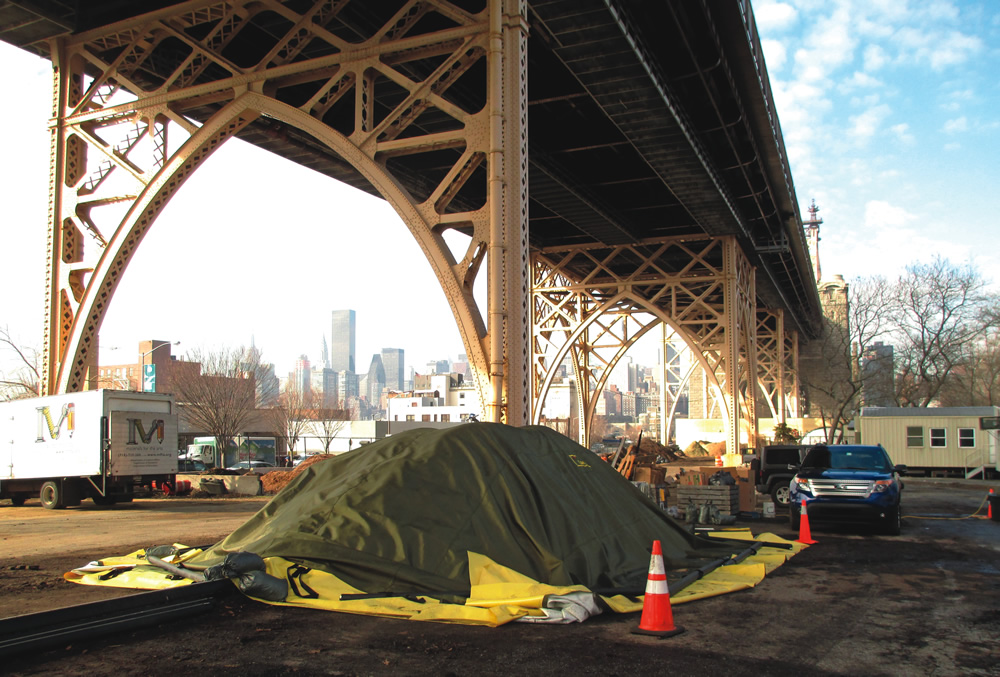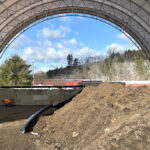The story of how a three-bin composting system in a community garden evolved into a full-fledged community composting facility on track to process over 300 tons of residential food scraps in 2015. Part III
Louise Bruce
BioCycle March/April 2014
Over a span of just five years, the New York City (NYC) Compost Project hosted by Build It Green!-NYC, grew from a three-bin composting system in a community garden to a city-funded program that locally processes over 250 tons of residential food scraps annually. This remarkable evolution of what is now BIG!Compost is the product of visionary founders, passionate staff and funders who believe in the importance of community-based composting.
In the fall of 2007, Queens resident Shirley Chai recently completed the NYC Compost Project’s Master Composter Certificate Course and was eager to put her new knowledge into practice. She rallied 20 fellow gardeners at Two Coves Community Garden to build a three-bin composting system. Among the gardeners were soon-to-be NYC Master Composters Leanne Spaulding and Stephanos Koullias. As community gardeners, Chai, Koullias and Spaulding understood the challenges of growing food in depleted and contaminated urban soils. They also discerned a growing and unmet demand for residential food scraps recycling. Inspired by what they had accomplished with Chai at Two Coves Community Garden, Koullias and Spaulding (now with the US Composting Council) set out to rebuild the soil in their community by accepting and composting their neighbors’ food scraps at a range of local sites. In 2009, they officially founded the Western Queens Compost Initiative (WQCI).
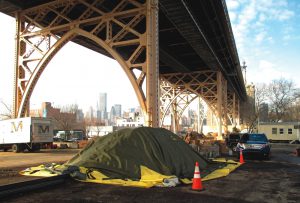
BIG!Compost recently installed a GORE cover system at its 10,000 sq ft community composting operation located under the Queensborough Bridge.
WQCI, staffed entirely by volunteers, partnered with more than a dozen local community organizations and institutions — including community gardens, a public library, community supported agriculture groups, and GrowNYC’s Queens Greenmarkets — to build a decentralized network of five conveniently located food scraps drop-off sites and six small-scale composting sites in western Queens. Some drop-off sites were hosted at the same location where the material was processed, such as in a community garden. Others were hosted at familiar community-based venues such as libraries and farmers markets located near composting sites. Koullias and Spaulding made sure the drop-off and composting sites were properly managed and used preexisting community networks to garner participation in both their drop-off program and composting operations. The resulting finished compost was used to grow food, revitalize street trees and improve soil in parks. Soon, it would become difficult to visit a public space in western Queens that hadn’t been improved by locally produced compost.
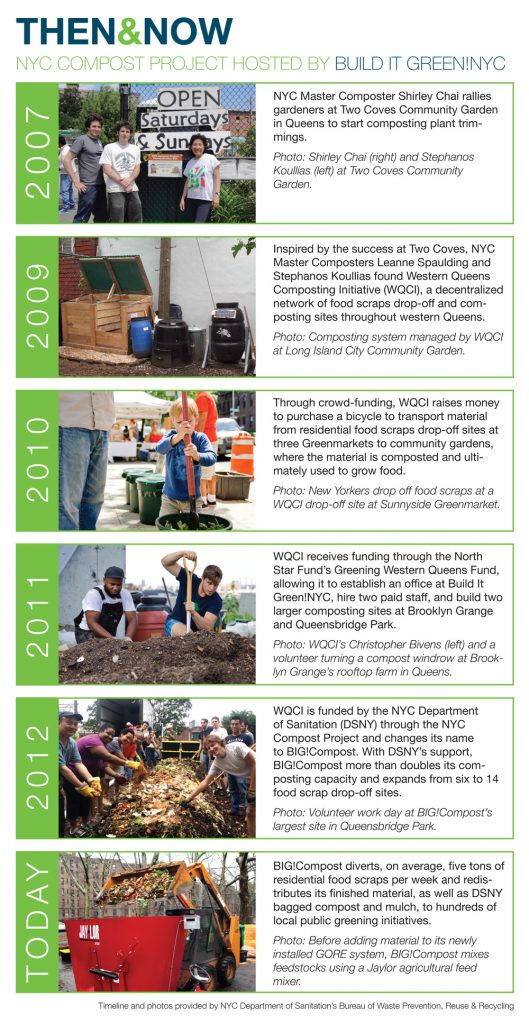 Getting Funded
Getting Funded
After a week-long power outage in July 2006, Western Queens Power for the People successfully led a campaign to hold Con Edison, the city’s main electricity provider, accountable for the blackout’s impact on local residents and businesses. The campaign resulted in a $63 million agreement that required Con Edison to reimburse those who lost power and to invest nearly $8 million into a fund devoted to energy efficiency and green infrastructure projects, including environmental education programs, street tree planting and stewardship initiatives, recycling programs, and green jobs training in the affected western Queens neighborhoods. The North Star Fund, a community foundation supporting grassroots groups, was selected to administer the fund and began accepting grant proposals in 2009.
The North Star Fund was impressed by WQCI’s application, titled “A Composter’s Dream,” which described a community-driven approach to organic waste management and exhibited a keen understanding of local demands and networks. The North Star Fund granted WQCI $15,000 with the potential of earning an additional $50,000 if it could raise matching funds. “North Star Fund is a risk taker, and often the first funder of emerging organizations before others are willing to invest,” explains Hugh Hogan, executive director of the North Star Fund. “The combination of new resources for urban forestry and innovative greening approaches that resulted from the Con Edison agreement, coupled with the founding vision and hard work of WQCI’s leaders, led our advisory board to take a gamble on this project.”
After being approached by WQCI about partnering to expand composting in western Queens, Build It Green!NYC (BIG!NYC), decided to match the North Star Fund’s grant by providing WQCI office space, insurance, supplies and facilities. “We were thrilled to host the Western Queens Compost Initiative,” says Justin Green, program director and founder of BIG!NYC. “Community-based composting was an exciting model to us because, rather than shipping food waste out and hauling the finished product back in, the composting takes place right here in our communities.” WQCI merged with Build It Green!NYC in 2010, changing its name as it grew beyond western Queens to Build It Green!Compost (BIG!Compost).
From 2010 to 2013, the North Star Fund granted more than $600,000 to BIG!Compost. The funding was used to hire and train staff, increase the number of food scraps drop-off opportunities, and expand composting operations. In 2011, it secured a site under the Queensborough Bridge, on land owned by the NYC Department of Parks and Recreation, and built an aerated static pile system. The added capacity allowed them to begin accepting food scraps from five additional GrowNYC Greenmarkets (see “Greenmarkets Facilitate Food Scraps Diversion In New York City,” February 2014). With the help of dozens of community volunteers, BIG!Compost processed approximately 10 tons of food with pitchforks and wheelbarrows each month.
City Takes Notice
Concurrently, the New York City Department of Sanitation’s Bureau of Waste Prevention, Reuse and Recycling (BWPRR) saw its NYC Compost Project-trained NYC Master Composters, such as Koullias and Spaulding, leading successful community-based composting initiatives in all five boroughs. It wanted to find a way to support these efforts and integrate these composting operations with its existing outreach and education.
In the spring of 2011, Robert Lange, Director of BWPRR, met with several groups led by NYC Master Composters to assess their existing capacity and interest in expanding. Lange asked each of the groups to develop a proposal outlining how they could expand their operations if they were funded by BWPRR. BIG!Compost, then still known as Western Queens Compost Initiative, delivered a compelling vision: It would steward a decentralized network of community composting sites. Stationed within community green spaces, it would engage with gardeners and community members in all stages of the composting process — from collecting organics to using the finished product. This model would give the organization flexibility to grow as new drop-off sites could be incorporated into its network as new processing sites were secured. This community-based network impressed BWPRR, which had historically focused on enabling residents to process their own food scraps in worm bins, in their backyards, or at community gardens. When visiting WQCI sites, BWPRR saw avid composters working closely with community gardeners to build greater support for and participation in composting in western Queens.
In the spring of 2012, after a year of conversations, negotiations and planning, BWPRR initiated the Local Organics Recovery Program (LORP). LORP sites focus on growing community-based composting operations, increasing opportunities for residents to drop off their food scraps locally, and building public support for composting. BIG!Compost was among the first programs funded by LORP.
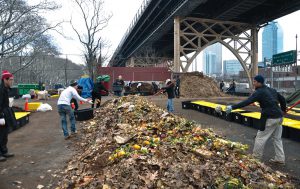
Volunteers participate in a windrow-build that incorporates residential food scraps from the Greenmarkets, which are transported to the composting site in 27-gallon rectangular tubs (on right).
BWPRR’s decision to support the program came at a pivotal moment for BIG!Compost and its supporters. As the Greening Western Queens Fund was nearing its end, city funding demonstrated the success of the North Star Fund’s investment and ensured that BIG!NYC could sustain the program’s growth. “As part of the agreement, the resources that flowed through North Star Fund’s Greening Western Queens Fund had to be granted within 36 months, so we needed the city to get behind the effort in order to sustain it,” notes Hogan.
By funding highly visible community-based composting initiatives dedicated to revitalizing the urban environment, like BIG!Compost, BWPRR’s NYC Compost Project demonstrates to the public that organic waste is not trash — it is a resource that can build healthier and greener cities as well as better-connected communities. “Through the NYC Compost Project, we’re changing the way New Yorkers see their apple cores and banana peels,” explains Lange. “We’re building an identity for composting and recycling at all scales, from backyards to industrial facilities.”
Big!Compost In 2014
Every week, BIG!Compost’s team of five accepts an average of five tons of food scraps at 16 residential drop-off sites — 10 of which run year-round — and from partner organizations including City Harvest and GrowNYC Greenmarkets. Most of the food scraps, which are received Saturday through Thursday, arrive frozen as most participating New York City households store food scraps in their freezers. BIG!Compost also accepts leaves and wood chips from local public parks, which are delivered to its site in bulk.
Most of these materials are composted on a 10,000 square foot, city-owned property directly beneath the Queensborough Bridge. As a New York State Department of Environmental Conservation registered facility, BIG!Compost can accept up to 1,000 cubic yards of source separated food scraps annually. However, because the processing site is located in close proximity to residences, a hotel, parks and light industrial activities, the team conducted extensive research to identify technologies and equipment from the composting and agricultural industries that would mitigate any potential negative impact on neighbors as site productivity increased.
Currently, BIG!Compost staff transport food scraps to its processing site in 64-gallon Organics2Go Toters on an 18-foot box truck. Within 48 hours after arrival on-site, they are emptied using a Toter® Mobile Cart Lifter into a JayLor A100 Self-Propelled Mini Mixer, an agricultural feed mixer used to mix food scraps with leaves and wood chips. Next, using a skid steer, they move the mix to a newly-installed Sustainable Generation Mobile™ System, which includes a tailor-made GORE® Cover System and automated temperature and oxygen monitoring.
Composting is divided into three phases. First, staff add incoming material to the GORE system in batches for the initial phase of active composting, which generally lasts four weeks. After the completion of this first phase, material is transitioned to two windrows and maintained with the skid steer and a fork attachment. In other operations designed by GORE, this second phase typically takes place under a GORE Cover as well. However, due to funding limitations, BIG!Compost manages phase two of its operation in an open windrow.
The cover system, which was installed in January, will enable BIG!Compost to compost up to 315 tons of food scraps annually at that site, reduce the labor required at each stage of the operation, and maintain better control of the process to ensure a high-quality product. “Sustainable Generation has taken the GORE® Cover System and scaled it down for use at community-based composting operations,” says Scott Wood, Sustainable Generation Founder and CEO. “We wanted to work with BIG!Compost to help the organization reap the benefits of a proven system that has been used at larger operations in Europe for over 20 years.”
In addition to providing funding for staff and operations expenses, the NYC Department of Sanitation (DSNY) also has helped to increase capacity by screening the finished compost at DSNY composting sites. This material is later distributed to nonprofit and community organizations working to revitalize public spaces across New York City. Some of the finished material feeds BIG!Compost’s vermicomposting operation, located at BIG!NYC’s Reuse Center in Astoria, about a mile from the composting site. BIG!Compost hopes to use this system to produce a higher quality product for New Yorkers who often garden in small spaces, such as on stoops and in window boxes.
BIG!Compost’s story evokes the question: Why continue to support community composting when NYC is again exploring the possibility of municipal composting? According to Lange, community-based composting programs are integral to changing New Yorkers’ attitudes toward generating and managing food scraps and yard trimmings. In contrast to municipal-run organics programs that introduce requirements to a public who is largely unfamiliar with and has little connection to the benefits of organics recycling, these community programs demonstrate up close that organic residuals are a valuable resource. “Whereas the benefits of a municipal food scrap collection program are often cast as reduced disposal cost and reduction in greenhouse gases, the benefits of a community-based program may be as close as your apartment window box and the flowers that flourish there,” says Lange.
Louise Bruce, formerly program manager at BIG!Compost, is now a public information specialist at the NYC Department of Sanitation’s Bureau of Waste Prevention, Reuse & Recycling (lbruce@dsny.nyc.gov). This article is the third in a series on community composting in New York City.


